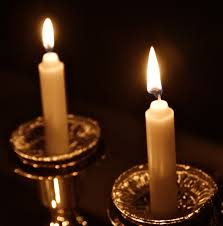
Until I was almost an adult, I thought there was a long mysterious prayer that women said when they lit Shabbat candles, beyond the initial blessing. This prayer took about 20 minutes. I assumed it was something intricate that had been passed down through the generations, and I wondered how I would ever succeed in learning it all by heart.
When I went to Israel at 17, I discovered there really is a traditional Hebrew prayer that one can choose to say after the blessing, which takes about five minutes, tops. And my mother didn’t know Hebrew.
So on a trip back to America, I asked her what it was that she said when she stood so long at her candlesticks. She answered, “I talk to God.”
I also talked to God, in addition to regular prayers. I talked to God when I was worried about something, or when I stood at the Kotel, or when I wondered what it was that He wanted from me. Sometimes I even remembered to talk to Him when something wonderful happened. So I could relate.
As for the candle-lighting talking to God – which I only commenced after I married – I found myself wanting to include everything into that first blessing, not as an addendum. The only way I could do that was through mental imagery, and since I’ve always been as connected to visual images as to words, it wasn’t difficult.
My method was simple. I would draw out the blessing while I imagined my various family members in my mind. This didn’t take an enormous amount of time. There was my husband and myself, my two brothers and my parents – plenty of time to focus on each.
As time went on, I added our children to the mix. Since they came into our lives one at a time, I had about two years to learn how to fit in each new image while saying that blessing. At one point, I was up to 12 images, all together, including my original nuclear family. You do the math.
This was a stable number for a while, and then my oldest daughter got married, and started having kids of her own. Naturally I wanted to include the grandchildren in my prayers, so I stood at the candlestick tray longer and longer. I didn’t just visualize each person’s face; I thought about what I wanted for them in life, how I’d like God to help them. All of this was predeeded, of course, by first having kavana, intent, for the actual words of the blessing itself – “…Who has sanctified us with His commandments and commanded us to light the Sabbath lights.”
And then I began to lose people.
My older brother died of an aortic aneurism in his ‘50’s. My mom passed away a year later. My father – less than two years after my mom. Even when a hectic week kept me from dwelling on my losses, I remembered them at candle lighting time, by their absence.
But then something wonderful happened. In the middle of these losses, two more daughters got married, and added more grandchildren, more faces and personalities to join me on Friday night at my candlestick tray.
On one Friday night I had an epiphany: The number I had plateaued at for some years, when I still had my entire original nuclear family and my unmarried children, had been surpassed, losses notwithstanding. I think demographers call it “population replacement”. To me, the discovery was that after I had lost those who were dear to me, even more had taken their place. At that moment I understood what my father said to me after his first grandchild was born. “Now,” he said, “I feel that my job is done. There is continuity.”
The greater discovery was that many of the wonderful qualities that had existed in those loved ones, who I lost, were present in the loved ones I had gained. This, more than the numbers, was the most poignant defining moment of my candle lighting experience.
Today, my mind is, thank God, crowded during that blessing, and each time I light, I sense that my mother is looking over my shoulder, smiling with nachat (pleasure), enjoying the crowd. I imagine her locking eyes with her grandchildren and great-grandchildren, offering them love, comfort, encouragement – whatever they need to enjoy a happier week.
There is a kabbalistic belief that under the wedding canopy we are joined not only by our living family, but by those who have left us. That is what I feel every week at my candlestick tray.
As the year turns, with holidays that come and go, and life cycle events that visit us all, I stand at those candles every Shabbat for a very long time, and I pray that every season will be a time of joy, health, love and faith, for all those gathered at my side, and for all those beyond it, who belong to other families, everywhere.
I may even add an addendum.
The author is a writer, an educational theater director (www.bible-arts.com) and the editor-in-chief of WholeFamily.com.
The words of this author reflect his/her own opinions and do not necessarily represent the official position of the Orthodox Union.
